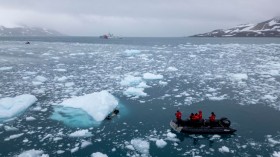NASA announced the third successful test of a balloon-launching system capable of delivering research instruments to high altitudes with a high degree of accuracy, opening up new doors for planetary scientists to study distant objects in our solar system and beyond.
The Wallops Arc Second Pointer, or WASP, can deliver balloon-borne equipment to targets with what NASA called "sub arc-second accuracy and stability."
"Arc-second pointing is unbelievably precise," said David Stuchlik, the WASP project manager at NASA's Wallops Flight Facility in Wallops Island, Va. "Some compare it to the ability to find and track an object that is the diameter of a dime from two miles away."
NASA scientists have successfully tested the WASP system three times, most recently in September 2013, when a 30-story balloon was launched to an altitude of 122,000 feet, a height that enabled the hoisted equipment to collect radiance data from the Earth, the Sun and the Moon.
Terry Hurford, with NASA's Observatory for Planetary Investigations from the Stratosphere (OPIS), said that even though balloon systems are less costly for research missions, planetary scientists generally have not used them to conduct research because they lacked the necessary accuracy.
"Planetary scientists really haven't been involved in balloon payloads," he said. "Planetary targets move with respect to the stars in the background. And because you need to track them to gather measurements, you need a system that can accurately point and then follow a target. These challenges are why planetary scientists haven't gotten into the balloon game."
This September Hurford plans to use the WASP system to study Jupiter and planets beyond the solar system, NASA said.
"Time for planetary observations on ground-based observatories is difficult to obtain," Hurford said. "Moreover, high-altitude balloons above 95 percent of the Earth's atmosphere allow for observations in the ultraviolet- and infrared-wavelength bands, which aren't possible with ground-based telescopes. High-altitude balloons offer us a unique, low-cost platform to carry out our planetary observations. This effort provides us with a unique opportunity to build a capability that we can leverage for future opportunities. WASP gives us a new platform," he said.
© 2024 NatureWorldNews.com All rights reserved. Do not reproduce without permission.





